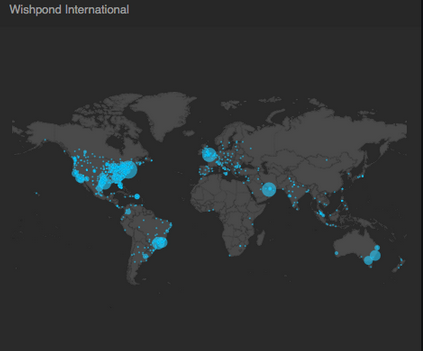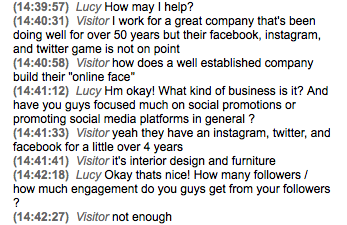
Dear Readers of the Wishpond Blog,
As an online marketing company we deal with people, lots of people.
All around the globe, 24 hours a day.

Wishpond’s global consumer base
We have customers in over 40 countries and almost 20 different time zones. They speak dozens of languages and send us hundreds of questions, comments, suggestions, insults, requests, rants and (occasionally) an inappropriate pick-up line.
Being an online business also means we have to work extra hard to develop relationships with our clients. We will likely never meet any of them face to face so it’s crucial we go that extra mile.
Upstream Without a Paddle
Starting out, it wasn’t pretty.
We were your standard internet startup, focused more on developing awesome tools than we were on developing awesome relationships. This is why, when Bree Nakatani (one of our current Customer Success Leads) joined Wishpond from a customer service role at a luxury hotel, she described our support department as both “laughable” and “appalling.”
Again, not ideal.
With Bree’s arrival, our company started to take a more proactive approach to customer support.
By dedicating time and effort to developing relationships with clients and non-clients alike, we saw a 15% decrease in refund requests over the course of a 6-month period in 2012.
We’ve now gone from a fairly non-existent support department to a full team of 8 members. We offer help via email, phone, live chat and video – 24 hours a day, Monday through Friday – in 8 different languages: English, Spanish, Portuguese, Italian, German and Russian to name just a few.
Usually our customers are surprised to learn they’re talking to someone in Vancouver, Canada, often from thousands of miles away. (And yes, for those of you wondering, our support members do ride either polar bears or dog sleds to work each morning like all Canadians).
Helping Others Succeed
Our most influential strategies to improve customer support:
1. Proactive live chat
Different from your standard live-chat, in which visitors to a site have to actively engage with a customer support lead, Wishpond chose to go to them.
Both our website and our blog feature a window that (once per day) pops up asking blog readers or site visitors if they have any questions about our tools or marketing in general.
Here’s an awesome example from our proactive live chat with Lucy, and why it’s great:

- She shows personality at the beginning, displaying she’s a real person and not just a robot (using “woo”, exclamation points and smiley faces).

- She gradually gets information about the visitor’s business without coming across as too pushy or rushed.

- She gives the visitor specific advice and solutions they can try. All of these solutions (such as online ads, landing pages, marketing campaigns and online discounts) Wishpond offers in its software, yet she’s not aggressively or blatantly promoting them.

- She finishes the conversation by providing the hours of live chat and forms a friendly relationship with the visitor.
2. Support of Non-Clients
Our proactive live chat means that oftentimes our support team is spending valuable minutes of their day talking to people who aren’t yet paying customers (something we were skeptical of initially).
But, as with literally everything Wishpond does, we A/B tested it, analyzing the conversion rates of customers who engaged with our team through chat versus those who did not. Doing this caused a noticeable increase in conversions on the pages that had the window.
“It’s exciting for our team to teach customers how to market their business from scratch. For us, the best feeling is seeing someone run a successful campaign, when a month earlier they knew nothing about online marketing.”- Bree Nakatani
No matter how large or how small our client (or even non-paying visitor to the site) is, we want them to succeed. That’s why the last 2 years we have dedicated ourselves to being better; to making customer service a true priority of our business.
Of course, we’re not going to pretend that we don’t like the increases in conversions, retention or sales, but we’ve found that (happily) when our customers succeed, our business succeeds as well.
3. Weekly Meetings
Our support team now has weekly meetings where goals are set and issues discussed. Led by Lucy, these meetings revolve around different examples of live chats, showing and discussing the best and worst from that week.
“Customer service and support is really all about learning from experience. If we’re ever faced with a challenging situation or customer we make sure to talk it out as a group. That doesn’t mean we don’t make mistakes. But when we do, we make a point of learning and constantly trying to be better together.” – Lucy
4. Using Educational Content to Find Support Success
One of our support team’s main strategies is to try and incorporate content into Wishpond’s customer service whenever possible.
Support gets swamped with questions each and every day. Because they have to answer them all, they know more than anyone what our customers want and need.
When we (the content team) are deciding what to write about next, the support team is the first place we go. They tell us what customers are looking for, and we write content to solve their problems or prevent them from being made in the first place.
Using content for support delivers value to our leads and clients. It increases the chance of them converting to a paid subscription or staying with Wishpond and becoming loyal customers.
Constant interaction with educational content also increases our support team’s own expertise and makes them more capable of doing their job exceptionally.
As Customer Support Lead Paige Tibbles says:
[Content] takes the pressure off of me having to tell [customers and visitors] exactly what to do. Instead I can make them do a bit of the work and figure it out themselves, by reading the tips and applying it to their own cases.;
Our team tries to use content to help and empower customers as often as possible. Here is a real-life example from Wishpond’s live chat with Paige:

By using content in our own support strategy, we’ve increased the efficacy of our support team and seen a measurable impact on retention since we started to implement it.
Here’s a step-by-step of how we introduced blog content into our support strategy:
Conclusion
Many businesses like ours, suffering the growing pains typical of any startup, initially put customer service on the backburner.
While this may work at first, without strong customer service your retention will suffer. We learned this the hard way and now realize the importance of prioritizing customer service for our business.
It wasn’t an overnight transformation. Heck, we know we’re not even close to perfect. As our tools, competitors and clients evolve, so must our customer service.
At least we’re no longer appalling.
– Written by Claire Grayston
Claire is a digital content marketer at Wishpond. When not racking her brain for new content, you’ll find her hiking or snowboarding the local mountains or cozied up in bed watching a sappy rom-com.
